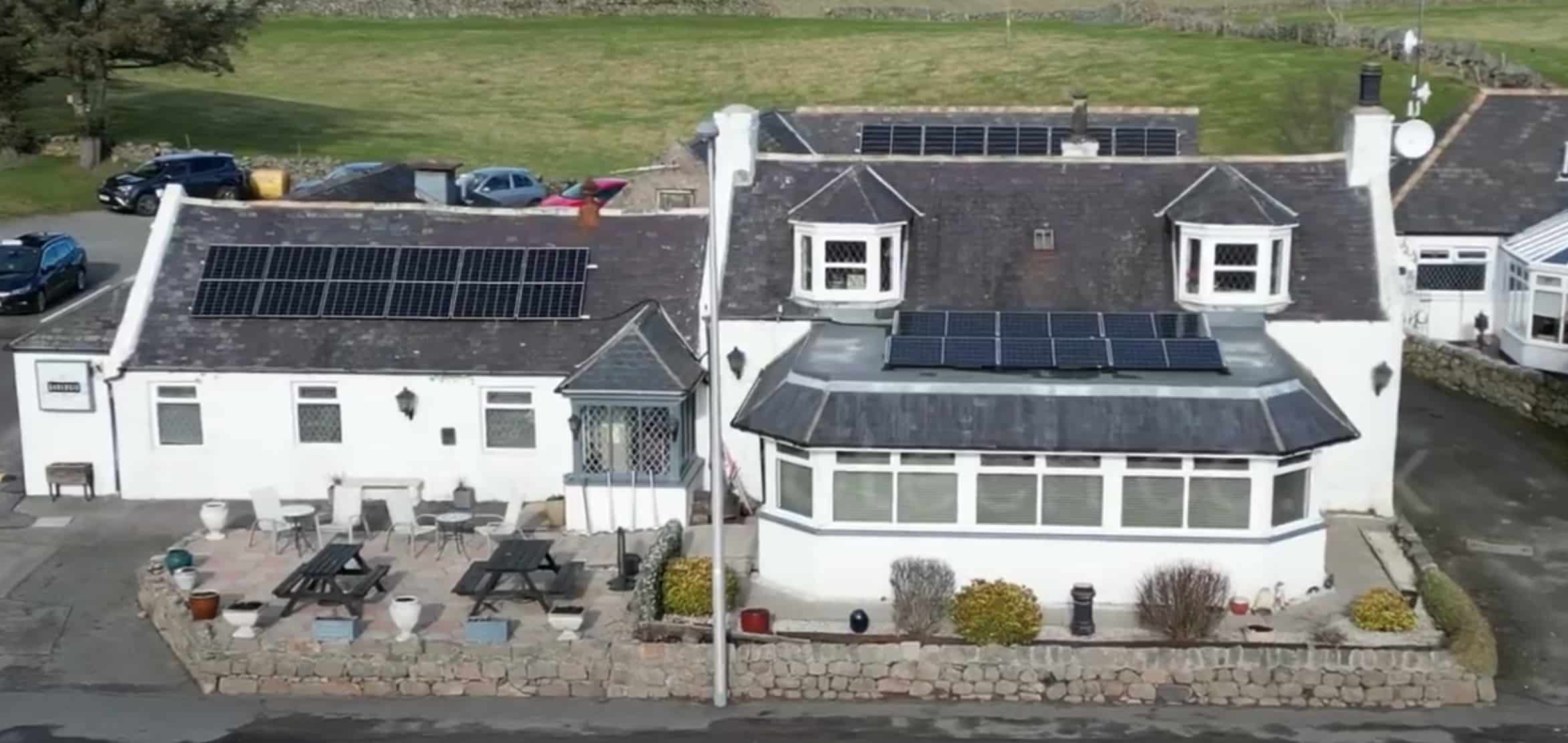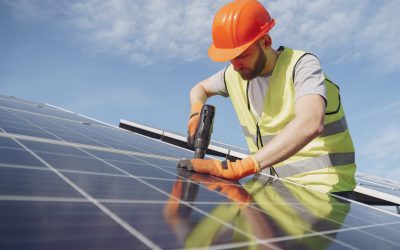As we continue our journey into solar energy, it’s essential to build on the foundation laid by earlier guides. Now, we focus on the tangible steps of installing your solar system, from procuring materials to ensuring your setup operates flawlessly.
Procurement of Materials
Identifying Quality Solar Panels and Components
When embarking on a solar panel installation project, understanding and choosing the right components is crucial. High-quality components not only ensure the longevity and efficiency of your solar power system but also maximise your investment.
Here’s a breakdown of typical solar system components and what to look for in each:
-
Solar Panels: The core component of any solar system, solar panels come in various types, such as monocrystalline, polycrystalline, and thin-film. Each type has its advantages in terms of efficiency, cost, and installation flexibility.
- Efficiency: Look for panels with higher efficiency ratings to maximize energy production, especially in limited space.
- Durability: High-quality panels are tested for harsh weather conditions and come with warranties of 25 years or more.
- Brand Reputation: Opt for manufacturers with a strong track record and positive reviews.
-
Inverters: Inverters convert the DC electricity generated by your panels into AC electricity, which can be used by your home or fed into the grid.
- Type: Choose between string inverters, microinverters, or power optimizers based on your system size and configuration.
- Efficiency: High-quality inverters have higher efficiency rates, ensuring minimal energy loss during conversion.
- Warranty and Support: Look for long warranty periods and responsive customer support.
-
Mounting Systems: The mounting system secures solar panels to your roof or the ground.
- Material: High-quality mounting systems are made of durable materials like aluminum or stainless steel to withstand environmental conditions.
- Compatibility: Ensure the system is compatible with your specific type of roof or installation surface.
- Wind & Snow Load: Check that the mounting system meets local building codes for wind and snow loads.
-
Solar Batteries (if applicable): Solar batteries store excess energy for later use, providing power during outages or periods of low sun exposure.
- Capacity & Power: Higher capacity and power ratings mean more energy storage and output, offering greater independence from the grid.
- Depth of Discharge & Lifespan: Look for batteries that offer a high depth of discharge (DoD) and long lifespan to ensure value over time.
- Warranty: A longer warranty indicates the manufacturer’s confidence in their product’s longevity.
-
Charge Controllers (for off-grid systems): Charge controllers regulate the flow of electricity from the panels to the battery and prevent overcharging.
- Type: MPPT charge controllers are more efficient than PWM types, especially in varying temperatures.
- Features: Look for additional features like data monitoring and automatic system shut down to protect your batteries.
When selecting components for your solar panel system, it’s not just about the individual quality of each part but also about how they work together as a whole.
Compatibility between components is crucial to ensure your system operates efficiently and effectively.
Always consult with a professional installer or do thorough research to make informed decisions based on your specific energy needs, environmental conditions, and budget constraints.
Where to Buy Solar Panels and Necessary Equipment
Purchasing solar panels and related equipment requires careful consideration of several factors including price, quality, and after-sales support.
In the UK, there are numerous reputable suppliers and platforms where you can acquire these components. Here’s a guide to navigating your options:
-
Specialized Solar Retailers: These are businesses dedicated solely to selling solar power systems and components. They often offer a wide range of products and can provide expert advice on the best options for your specific needs. Examples include The Solar Centre and Navitron.
-
Renewable Energy Specialist Companies: Companies such as Eco Green Energy and SunPower not only sell solar panels and systems but also offer installation services. They can provide comprehensive solutions from the assessment of your energy needs to the installation and maintenance of your solar system.
-
Online Marketplaces: Platforms like eBay and Amazon have a variety of solar panel systems and components available from different sellers. While you might find competitive prices here, ensure you’re buying from a reputable seller with good reviews and a track record of selling genuine, high-quality solar products.
-
Direct from Manufacturers: Some manufacturers sell directly to consumers. Purchasing directly can sometimes mean lower prices and better support. Research manufacturers with a strong presence in the UK market, such as LG Solar, Panasonic, and Sharp.
-
Local Hardware and Home Improvement Stores: Stores like B&Q and Homebase occasionally stock solar panel kits and components. While the range might be more limited compared to specialized retailers, they can be a convenient option for basic systems or individual components.
Tips for Cost-Effective Solar Panel Procurement
-
Research and Compare: Look into multiple suppliers and compare their offerings in terms of product range, prices, warranties, and customer reviews.
-
Check Certifications: Ensure the solar panels and components are certified by relevant authorities (e.g., MCS – Microgeneration Certification Scheme in the UK) for quality and safety standards.
-
Understand Warranty Terms: Pay attention to warranty durations and what they cover. A longer warranty period is often an indicator of a quality product.
-
Seek Recommendations: Ask for recommendations from friends, family, or online forums who have installed solar systems. Personal experiences can guide you to reliable suppliers.
-
Consider After-Sales Support: Choose suppliers that offer good after-sales support, including help with installation, maintenance advice, and assistance with any issues that may arise.
Purchasing solar panels and equipment is a significant investment towards a more sustainable future. By carefully selecting where to buy your components, you can ensure a smooth installation process and enjoy the benefits of solar energy for years to come.
Calculating Your Needs and Sizing Your System
To ensure your solar panel system is neither underpowered nor excessively costly, accurately sizing it based on your energy needs is critical. Here’s a step-by-step guide to help you through this process:
Assess Your Energy Usage
First and foremost, understanding your current energy consumption is essential. This involves:
-
Reviewing Past Electricity Bills: Collect your electricity bills for the last year to get a comprehensive view of your annual energy consumption, usually measured in kilowatt-hours (kWh).
-
Identifying Consumption Patterns: Pay attention to monthly fluctuations in energy use, which can help identify peak usage periods. Your solar system should be capable of accommodating your highest energy needs.
Estimate Your System’s Energy Production
The potential energy production of your solar system depends on several factors, including:
-
Panel Efficiency: Solar panels convert sunlight into electricity with varying degrees of efficiency. Higher efficiency panels produce more electricity from the same amount of sunlight.
-
Solar Insolation: The amount of solar radiation, or insolation, your location receives directly affects how much energy your panels can generate. This is measured in kWh per square meter per day.
-
Shading and Orientation: Consider the impact of shading and the orientation of your solar panels. Panels should ideally face south in the Northern Hemisphere to maximize exposure to sunlight.
Determine the Size of Your Solar System
Combining your energy needs with the potential production capacity of solar panels will guide the sizing of your system:
-
Daily Energy Needs: Divide your annual energy consumption (in kWh) by 365 to find your average daily energy needs.
-
Solar Panel Output: Calculate the expected daily output of your solar panels. You can use an average output of 4 kWh per day for a 1 kW system as a rough guide, but adjust this based on your specific location’s insolation and the efficiency of your chosen panels.
-
System Size Calculation: The size of the solar system you need can be estimated by dividing your daily energy needs by the daily output per kW of solar panels, adjusted for efficiency and local conditions.
Consider Future Energy Needs
-
Energy Efficiency Improvements: Before finalizing your system size, consider any planned energy efficiency upgrades to your home that could reduce your future energy needs.
-
Expansion Potential: It’s also wise to think about future energy needs due to lifestyle changes or additional family members. Ensure your system design allows for easy expansion.
Example Calculation
If your home consumes 10,000 kWh per year and you have an average of 4 peak sunlight hours per day with panel efficiency taken into account, the calculation for your system size would be approximately:
≈ 6.85 kW
This means you would need a solar panel system around 7 kW in size to meet your current energy needs, depending on the specific conditions and efficiency of your setup.
By meticulously assessing your energy usage and considering the factors affecting solar production, you can accurately size a solar panel system that meets your needs efficiently and effectively.
If this sounds too complex, we suggest enlisting the help of an expert, such i-Protech, who can do all the hard work for you.
Installation Process
Preparing the Site for Installation
Before the actual installation of solar panels begins, one of the most critical steps is ensuring the installation site, typically your roof, is ready and suitable. This preparation phase is vital for the safety, efficiency, and longevity of your solar power system. Here’s what this process involves:
Assessing the Roof’s Condition
The condition of your roof is paramount as it will be supporting the additional weight of the solar panel system for decades. Here’s who should perform the assessment and what they should check:
-
Hiring a Professional: A qualified roofing contractor or a structural engineer should assess the roof. These professionals can accurately evaluate the roof’s condition, identify potential issues, and recommend necessary repairs or reinforcements. For integrated solar systems or installations on unusual roofing materials, involving a solar installation specialist with roofing experience is also wise.
-
What to Check:
- Age and Remaining Lifespan: Ensure your roof is in good condition and has a significant remaining lifespan. Installing solar panels on a roof that requires replacement soon is not advisable.
- Structural Integrity: The professional should check the structural integrity of the roof to ensure it can support the additional weight of the solar panels. This includes examining the rafters, trusses, and sheathing.
- Roof Load Capacity: They should calculate the roof’s load-bearing capacity to confirm it can handle the weight of the solar panels plus potential snow accumulation. This is particularly important in areas with heavy snowfall.
- Condition of Roofing Material: The condition of the roofing material itself should be assessed. Brittle, damaged, or worn-out materials may need to be repaired or replaced before installation.
- Roof Layout and Obstructions: The layout of the roof and any obstructions such as chimneys, vents, and skylights should be considered. These can affect where panels can be placed and how many can fit.
Ensuring Structural Integrity
Based on the assessment, you may need to undertake repairs or reinforcements to ensure your roof is ready for solar panel installation. This could include:
- Reinforcing Roof Structure: If the existing roof structure is found to be inadequate for the additional load, it may need to be reinforced. This can involve adding support beams or reinforcing rafters.
- Replacing Roofing Material: If the roofing material is near the end of its life or in poor condition, it’s often more cost-effective to replace it before installing solar panels.
- Clearing Obstructions: In some cases, it might be necessary to remove or relocate roof obstructions to maximize the usable space for solar panels.
The Step-by-Step Guide to Mounting Solar Panels
Mounting solar panels is a critical task that requires accuracy to ensure the panels are securely attached and positioned for optimal energy production. Here’s a detailed look at each step:
1. Preparing the Mounting Area
- Roof Cleaning: Begin by cleaning the roof surface where the mounting system will be installed. Remove any debris, dust, or objects that could interfere with installation.
- Safety Measures: Set up safety equipment such as harnesses, ropes, and anchors to prevent falls. Safety should always be the top priority.
2. Installing Mounting Brackets
- Locating Rafters: Use a stud finder or other methods to accurately locate the rafters on your roof. The mounting brackets must be attached directly to the rafters for maximum strength and stability.
- Securing Brackets: Drill pilot holes into the rafters at the marked locations. Use sealant around each hole to prevent water penetration. Attach the mounting brackets using stainless steel lag screws, ensuring each bracket is flush and securely fastened.
- Waterproofing: Apply additional waterproof sealant around each bracket to create a watertight seal, protecting against leaks.
3. Attaching the Rails
- Aligning Rails: Mount the rails onto the brackets. These rails are the support structure on which the solar panels will be mounted. Ensure they are perfectly aligned and level across the entire roof span.
- Securing Rails: Fasten the rails to the mounting brackets using the provided hardware. It’s crucial to check that all connections are tight and secure to prevent any movement.
4. Mounting the Solar Panels
- Placing Panels: Carefully lift each solar panel onto the mounting rails. Follow the previously designed layout, ensuring each panel is positioned for maximum sun exposure.
- Securing Panels: Use clamps to secure the solar panels to the mounting rails. There are typically two types of clamps: end clamps and mid clamps. End clamps secure the outer edges of the panel array, while mid clamps are used between panels to secure them side by side.
- Wiring: Once all the panels are in place, connect them according to your electrical design. This might include attaching each panel to an optimizer or directly connecting the panels in series or parallel configurations.
Electrical Connections and System Integration
Integrating solar panels with your home’s electrical system involves specific steps and adherence to UK regulations. This ensures the safe and efficient operation of your solar power system.
Here’s a revised detailed breakdown tailored for UK commercial or homeowners who want to install solar panels:
1. Wiring the Solar Panels
-
Connecting Panels to an Inverter: In the UK, the DC electricity generated by your solar panels must be converted into AC by an inverter, a requirement for compatibility with the home and national grid. The panels can be connected in series or parallel, depending on the design that best suits your roof layout and optimizes efficiency.
-
Series vs. Parallel Connections: A series connection is commonly used for uniform arrays without shading issues, increasing voltage to match the inverter’s requirements. Parallel connections are beneficial for mitigating the effects of partial shading or when panels are oriented in different directions.
-
Safety and Isolation Switches: It’s crucial to install DC isolator switches close to the panels and an AC isolator switch near the inverter, as per UK safety regulations. These allow for safe maintenance and emergency disconnection.
2. Inverter Installation
-
Location Considerations: The inverter should be placed in a cool, ventilated area to prevent overheating. Proximity to the main electrical panel simplifies connections and complies with UK wiring regulations.
-
Connection to the Home Electrical System: The inverter’s AC output is connected to your home’s electrical panel. This should be done by a certified electrician familiar with the IET Wiring Regulations (BS 7671) to ensure compliance and safety.
3. Grid Connection and Metering in the UK
-
Microgeneration Certification Scheme (MCS): To connect your system to the grid and be eligible for any available feed-in tariffs or smart export guarantees, your installation must be carried out by an MCS-certified installer, and the equipment used must also be MCS-certified.
-
Net Metering and Export Tariffs: The UK’s smart export guarantee (SEG) requires a smart meter to track the electricity exported back to the grid. Your energy supplier will pay you for this exported electricity, contributing to your system’s payback.
Inspection and Testing
After the solar panels and electrical systems are installed, a thorough inspection and testing phase is crucial. This phase confirms the installation’s integrity, safety, and functionality before it becomes fully operational. In the UK, this involves several key steps, adhering to national standards and regulations:
Visual Inspection
-
Check Mounting and Fixtures: Ensure all solar panels are securely mounted, with all racking systems correctly aligned and tightened. Inspect the roof for any signs of damage or leaks caused during installation.
-
Verify Electrical Installations: Examine the wiring, conduits, and connections for neatness, proper routing, and compliance with the UK’s wiring regulations (BS 7671). All electrical components, including inverters and isolator switches, should be securely mounted and accessible.
-
Inspect Safety Signage: Safety labels and warning signs should be visibly placed as required, indicating electrical hazards and providing essential safety information.
Electrical Testing
- Continuity Testing: Checks are made to ensure that electrical connections are sound and that there are no open circuits in the system’s wiring.
-
Insulation Resistance Testing: This test verifies that the insulation of electrical wiring and components is intact, preventing electrical leaks that could lead to shocks or fires.
-
Polarity Testing: Ensures that all connections have been made in the correct polarity, a critical check for DC systems like solar installations.
-
Earth Fault Loop Impedance Test: Confirms that the system’s earthing is effective and meets the requirements to safely dissipate any fault currents.
-
Inverter Test: The inverter’s operation is checked, ensuring it correctly converts DC to AC and matches the output requirements of the household or grid.
Performance Verification
- Output Measurement: Once the system is deemed safe, its output is measured under normal operating conditions to ensure it meets the expected performance levels based on the system’s design specifications.
-
Shading Analysis Re-Verification: If initial shading analyses were conducted, these might be re-verified to ensure no unexpected shading impacts the system’s performance.
-
Monitoring System Check: If a monitoring system is installed, it’s tested to confirm it accurately tracks and reports the system’s performance data.
Compliance and Documentation
-
MCS Certification and Documentation: For installations in the UK, ensuring the system is MCS certified is crucial for compliance. The installer should provide an MCS certificate for the installation, along with a complete handover pack that includes manuals, warranty information, and detailed system diagrams.
-
DNO Notification: Confirmation that the Distribution Network Operator (DNO) has been notified and approved the connection, if the system is connected to the grid.
-
Building Control Notification: Ensuring that the local building control has been notified of the electrical work, as required under Part P of the Building Regulations in England and Wales, is essential for legal compliance.
NEXT STEPS
After Initial Consultation, Design and Engineering, Permit and Documentation has been completed the next stage is the handover, maintenance plans, and installation challenges.
To get a high level understanding of the process see the solar panel installation overview.
Conclusion
Embarking on a solar panel installation project can be a rewarding endeavor, offering significant environmental and financial benefits. By following the guidelines and tips provided in this guide, you can ensure a successful installation that maximizes the advantages of solar energy.
With the right preparation, materials, and knowledge, transitioning to solar power can be a smooth and efficient process. Whether you’re a homeowner looking to reduce your carbon footprint or a business seeking cost-effective energy solutions, solar panel installation is a step toward a brighter, more sustainable future.

About Stuart Munro
Stuart Munro, Director of i-Protech Technology and i-Protech Renewables Ltd, has almost a decade of expertise with renewable energy. Stuart has solidified i-Protech’s stature as a leader in solar energy and battery storage solutions. His commitment to renewable technologies has not only advanced the company’s portfolio in electrical and security systems but also underscored his dedication to environmental stewardship.





